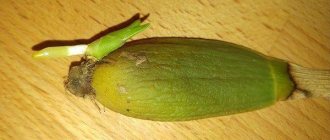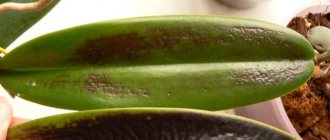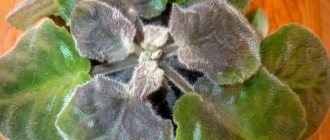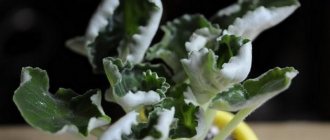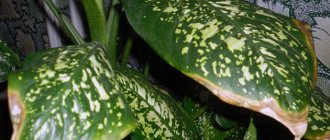The homeland of indoor violets is East Africa; the plants are very sensitive to cold and react sharply to even a short-term drop in temperature. Excessive humidity and soil acidification are the main factors deteriorating the condition of the outlet. If spots appear on it, it means that the rules of agricultural technology are being violated. There may be several reasons why violet leaves turn black around the edges. It is important to eliminate them in a timely manner and save the delicate plant.
Why do violet leaves turn black around the edges: the main reasons for the deterioration in the appearance of the rosette
The homeland of indoor violets is East Africa; the plants are very sensitive to cold and react sharply to even a short-term drop in temperature. Excessive humidity and soil acidification are the main factors deteriorating the condition of the outlet. If spots appear on it, it means that the rules of agricultural technology are being violated. There may be several reasons why violet leaves turn black around the edges. It is important to eliminate them in a timely manner and save the delicate plant.
What causes spots on leaves?
Flower growers know how demanding violets are to care for. Sissies cannot tolerate dry air, bright light, drafts or frequent watering. Any violations of the recommended agrotechnical care rules lead to a deterioration in the condition of the flower. Violet needs a balanced diet; with a lack of nitrogen and potassium, the plant begins to wither. To help him, it is necessary to understand the cause of the disease.
Sunburn
Saintpaulias standing on a windowsill are susceptible to burns. Due to direct sunlight, dry, brownish spots appear on their leaves. Plants need protection; you should hang a curtain or blinds on the window or choose another place to grow flowers. Dried leaves will not recover; they are removed. Lack of lighting also leads to problems with leaves. The short period of natural light must be supplemented by installing a lamp.
Frostbite and draft
A few seconds in the cold air when ventilating the room in the cold season is detrimental to Saintpaulia. Their leaf blades begin to darken at the edges. Gradually the spots spread over the entire surface. The flower does not require treatment; you can remove the leaves and wait for the rosette to be restored due to new growth. A draft at any temperature will cause light or brown spots to appear on the leaves.
Advice. Protect Saintpaulia from temperature changes.
Overmoistening
Excessive moisture is the main reason why violet leaves turn black around the edges. If the damaged areas are dark and soft to the touch, the flower is filled with water. Stop watering temporarily and let the soil dry out. In the future, moisten the plant only after the top layer of soil has dried. If the condition of Saintpaulia does not improve, it is necessary to inspect the root system. Perhaps a large number of roots have rotted. The flower is removed from the pot and the soil is removed. Diseased roots are cut off and the plant is transplanted into new soil. It is recommended to remove peduncles and stepsons, this will make it easier for the violet to adapt to a new location.
Stains may appear when water drops on the socket. Moisture causes the hairs on the leaves to rot and a brown area appears. Cold water is especially dangerous for violets. For irrigation, settled warm liquid is used.
Priming
For normal development, violets need light, loose soil that allows air to pass through well. Over time, the soil sags and becomes denser. The roots do not receive enough oxygen and begin to rot. The process accelerates under waterlogged conditions. With dense soil, even moderate watering becomes a problem. The lump of earth sticks together and does not dry out.
Brown spots appear on violet leaves due to lack of nutrition. There are no minerals left in the soil that the plant needs. Feeding with potassium fertilizer can correct the situation. If the flower has not been replanted for a long time, then salts have accumulated in the soil, interfering with the absorption of nutrients. In this case, the only correct solution is a transplant. The new pot should not be larger; the optimal ratio is the diameter of the container is 1/3 of the diameter of the outlet.
Attention. Don’t forget to add perlite to the soil, add drainage to the bottom of the pot, and drain the water from the pan after watering.
What to do if the violet dries out (the leaves of the indoor violet)
A small decorative flower with delicate velvet leaves, the violet is very beautiful, but at the same time it is very sensitive to the conditions of its maintenance.
It happens that a plant suddenly begins to show signs of illness and why a violet dries is not always easy to understand, because there can be many reasons. Let's consider the most likely factors that can cause Saintpaulia leaves to begin to wither, turn black, become covered with brown spots and dry out.
Reasons why violets may dry out
The difficulty is that it can be difficult to immediately decide what the problem is. Violet, in general, is very capricious and can express any discomfort through an unhealthy appearance.
And yet there are the most likely reasons why the leaves of the plant begin to dry out.
Too much sun
Saintpaulia is a heat-loving plant, its homeland is Africa. But the flower does not tolerate direct sunlight. In its homeland, violet grows in the thick of the jungle and on the slopes of mountains, but not on the southern side, but where direct exposure to the sun is not so long.
If your pot is on a south-facing windowsill and the sun shines into the room most of the day, the violet may not like it. Its delicate leaves simply burn under the rays. They quickly begin to turn yellow and dry out.
To save Saintpaulia, move the pot to a place where there is a lot of light, but there is no direct sunlight.
Overfilling or underfilling
If the leaves of a violet turn black, this indicates excessive watering. Darkening usually starts at the ends. Gradually the entire leaf begins to wither and falls off. When there is too much water and the soil does not have time to dry out, the violet roots begin to rot.
If you notice blackening, you should definitely check the roots. Carefully dig the plant out of the soil. If rotten roots are detected, you need to remove all spoiled remains and replant the plant in a fresh substrate.
With a lack of moisture, the leaves turn brown, turn yellow, become dry, and shrink. Actually, any plant will begin to dry out when it is not watered for a long time.
The peculiarity of violets is that they instantly react to any factor that causes them inconvenience.
In this case, it is enough to normalize the watering of the Saintpaulias and they will return to normal.
Pests
Drying of the leaves can be caused by mites. They often nest on the underside of leaves, and their sizes are so small that they are almost invisible to the eye. The leaves begin to become covered with yellow-brown spots on top and gradually dry out.
Some types of fungus also cause the flower to wilt. To detect parasites, carefully examine the flower from all sides through a magnifying glass. If you notice pests, isolate the violet from other flowers and urgently take measures to destroy harmful organisms.
Lack or excess of fertilizers
Saintpaulia needs to be fed all year round. This is done more often in summer, less often in winter. One of the reasons why violets dry out may be excessive watering with fertilizers or, conversely, a lack of nutrients.
With insufficient feeding, the plant slows down its growth, stops blooming, new leaves remain small, and the lower ones gradually die off.
When there is too much fertilizer, the leaves can dry out very quickly, usually at the edges.
If you suspect this is the reason, it is better to replant the plant and adjust the feeding regime.
General advice on what to do if a violet withers and dries
- Remove damaged leaves immediately; they will not recover anyway, and the plant will have to spend a lot of energy maintaining their vital activity.
- If you find signs of disease, remove the violet away from other flowers, as there may be pests on it and your neighbors risk infecting them too.
- Regardless of the cause of the disease, it is better to transplant the flower into a new substrate.
- Violets are very sensitive to microclimate; it must be stable. Avoid room temperature changes, drafts, and stuffiness.
- Water only with purified warm water.
- Bathe your violets from time to time, this will support their immunity.
- In winter, heat-loving plants are especially vulnerable; monitor them carefully.
Even a very experienced florist will not be able to immediately tell you why the violet is drying up.
You will have to carefully review every possible cause and change the conditions of care.
It is not always possible to save the plant. But even if things are bad, you can try to revive the cutting by cutting it at the root, removing most of the leaves and placing it in water so that it takes on new roots. Very often in such cases the violet begins a second life.
Source: https://ymadam.ru/sohnet-fialka-v-chem-mogut-byit-prichinyi.html
Spots as symptoms of disease
To exclude or confirm concerns about the appearance of diseases and pests on the violet, it is necessary to carefully examine the leaves. It is recommended to use a magnifying glass. This will help you see the microscopic mites. If brown, gray or white spots appear on the leaves of your violet, it could be a fungus. Late blight, powdery mildew and gray mold are types of fungal infections that affect Saintpaulias. The occurrence of diseases is promoted by hypothermia, excess moisture, and weakened immunity. Treatment depends on the type of fungus; the affected flower must be isolated from the rest of the collection.
The cause of the spots can be determined by analyzing the agricultural technology used. First of all, the structure of the soil, the degree of its moisture and the condition of the root system are determined. It is also worth paying attention to the climatic conditions of detention. High temperatures from +30-32°C lead to overheating of the soil and damage to the socket. Don't forget to feed the flower once every two weeks. If you quickly fix the problem, the violet will soon recover. In difficult cases, the variety is preserved by rooting the leaf or cutting off the top.
Other changes to the sheet plate
The reasons why the violet leaves are covered with spots of other colors:
- On the leaves of violets, dry white spots appear from spraying . It is better not to do this at all or to blot the moisture with a paper napkin;
Dry white spots may appear as a result of exposure to water.
Read more about the reasons for the appearance of white spots in this article.
- white mesh on the leaves - a freshly washed and not dried plant was placed in a lighted place ;
You can read more about what causes white spots on violet leaves in this article.
- lightened edges of the leaf plate - overfeeding with phosphorus fertilizer with a high content of perlite in the soil . Requires replanting into a substrate with a lower perlite content and feeding with a balanced fertilizer;
You can get more information about the prerequisites that contribute to the lightening of leaves here.
- “pale” leaves – too much sunlight or lack of iron . Shade the flower and water it with a product containing iron;
Leaves turn pale from overexposure or lack of iron.
Read more about why the leaves turn pale here.
- The spots are black on top and translucent on the back - Saintpaulia is sick. This may be late blight or bacteriosis . Urgent rooting or replanting is necessary;
Comprehensive information about why dark spots appear is given here.
- the edge of the leaf has turned black and dried out - necrosis . Perhaps it is too high humidity, low temperature or overdrying of Saintpaulia. It is necessary to adjust the conditions of detention;
- There are transparent dots on the back side of the sheet plate - waterlogging of the soil. It is necessary to dry the substrate and adjust watering;
The appearance of transparent dots indicates excess watering.
- purple or burgundy spots on the upper and lower sides of the leaf - natural pigmentation , a protective reaction of the plant to external conditions.
Why violet leaves turn black: treating the disease and eliminating other houseplant problems
Violet is a very beautiful indoor flower. But sometimes flower growers are faced with problems such as deformation of leaves, the appearance of spots on them, lack of flowering and other troubles. As a rule, this may be caused by pests or diseases of violets that have settled on the flower. Today we will talk about the signs of a plant disease, the reasons for its occurrence and what the treatment should be.
Errors in care
Leaves of flowers often turn yellow. Why does this happen, and what should be the treatment? In this case, it is pointless to treat them with chemicals, since this is caused by improper care. Most often, yellowing of leaves is caused by a lack of lighting, moisture or a deficiency of nutrients in the soil. Therefore, in order for your pet to be healthy and beautiful, you need to provide her with proper care.
Signs of infectious diseases
The appearance of an infectious disease is primarily indicated by the appearance of the flower; it becomes sluggish, its leaves fade and become smaller. Such signs usually indicate the appearance of the following diseases:
Powdery mildew
The main sign of its appearance is a gray coating on the violet leaves. Why does the disease appear and how to treat it? This disease most often appears with a lack of lighting, low temperature and high humidity. Quite often, the cause of powdery mildew is an excess of nutrients in the soil.
To save a flower, you need to spray it with Fundazol or Benlat. Many people ask the question, is it possible to spray violets? We answer, it is possible and even necessary, otherwise it will not be possible to save the plants. As a preventative measure, it is necessary to regularly wipe the leaves of the flower and periodically ventilate the room.
Common diseases with photos
Saintpaulias can be affected by various pathogens of viral, bacterial and fungal origin; here are the most common and dangerous of them.
Powdery mildew
In the initial stage of powdery mildew disease, a small white coating appears on the leaves and petioles, resembling scattered flour. As the fungus spreads, it damages all parts of the violet, the leaves become uneven, the plant becomes depressed and dies. To prevent the appearance of powdery mildew, prevention is carried out as follows: reduce the supply of nitrogenous fertilizers, watering and air humidity, ventilate the room with violets.
Downy mildew is caused by fungi from the peronosporaceae family. Symptoms of damage will be different:
- a silvery coating appears on the underside of the leaf;
- then light green, brownish, red-brown spots appear on the upper surface of the leaves;
- Without treatment, the plant weakens, withers and dies.
Late blight
A dangerous fungal disease that causes damage to the roots and then to the above-ground parts of the violet. The first sign may be wilting of leaves with sufficient watering. As it spreads, late blight causes root rot, the stems become brown in the affected areas, and the leaves also become covered with brownish-brown spots. High soil and air humidity promotes the growth of fungus.
Rust
A fungal disease that is easily recognized by brownish spots on the top of the leaves. On the inner surface of the leaves there are colonies of the fungus - yellow tubercles. More often, plants develop rust during the transition from winter to spring, when their immunity decreases. You need to know how to fight infection - with the help of broad-spectrum fungicides.
Fusarium
The causative agents of this disease are fungi from the genus Fusarium, which penetrate the root system from contaminated soil and then spread through the conducting vessels of the entire plant. The fungus cuts off the nutrition and water supply of the plant, causing its rapid death. The petioles of the leaves begin to darken and fall off, the roots are black when examined and do not hold the earthen ball. The plant can be saved only in the initial stage of the disease.
Gray rot
Gray rot, or botridia, is one of the main diseases of violets, also of a fungal nature. Furry spots of mold appear on the leaves and buds of an infected violet. It is necessary to fight the fungus with the help of fungicides, it is necessary to reduce the humidity of the room and watering, and arrange ventilation.
Disease Prevention
The best method of combating plant diseases is prevention. To prevent violet diseases, you must follow some rules:
- When purchasing a flower, it is recommended to isolate it from other indoor plants for the adaptation period, as it may be diseased.
- Inspect the flower regularly. When the first signs of disease appear, be sure to isolate the plant and begin treatment.
- Be sure to treat the soil with fungicides before planting, this will help prevent diseases of violets.
Follow these simple rules, and your indoor beauty will delight your eyes with its beauty, abundant and long-lasting flowering.
Prevention
The best prevention is to grow violets in an environment that is comfortable for them, observing all care requirements. If a flower is purchased, it is quarantined for 10-14 days to avoid infection or the transfer of insects to the home flower garden.
- keep the pot on the windows in the east, northeast direction;
- do not plant in large containers (pot diameter is 1/3 of the rosette diameter);
- maintain optimal temperature conditions (20-25 °C);
- feed with fertilizers developed specifically for violets or halve the dose of universal complex fertilizers;
- exclude contact with wildflowers and vegetables;
- observe the watering regime, drain excess water from the pan;
- do not spray the outlet in the sun, use a napkin to remove water after spraying;
- Disinfect your own soil.
Spots of various colors, including brown, on violet flowers and leaves are a consequence of improper care, infection, and pest damage. To avoid this, you need to properly care for violets at home, regularly inspect the plant to monitor its condition and take urgent measures if necessary.
Source
The main question: why do violet leaves darken?
Violets are very sensitive to various changes in living conditions, as well as to diseases. The leaves are the first to signal problems; they may turn black, wither, dry out or rot, but each symptom has its own problem.
For various reasons, violet leaves may darken.
If treatment is applied incorrectly, it may not only not help, but also cause harm . Also, the lack of treatment leads to complications of problems that can cause the death of the individual.
Rules of care
Compliance with the optimal requirements for violet content will allow you to avoid all these problems.
The best conditions for growing Saintpaulia:
- lighting should be diffused, but bright enough;
- daylight hours 10-12 hours;
- temperature 18-24 degrees;
- regular watering with soft water;
- loose soil;
- properly selected pot;
Then the violet with its emerald leaves will say: “Thank you, I’m fine.”
Why do violet leaves darken?
If your violet appears blackened on the leaves, on the tips, or in spots, the first thing you need to do is determine the cause. Among them, only two main directions :
- Errors in care;
- Fungal diseases.
Each of the reasons consists of factors that can be included in it, and knowing them you can :
- Determine the direction of treatment;
- Or bug fixes.
Each of them leads to its own consequences, which together can lead to blackening of the leaves.
Errors in content
One of the most common problems. Caring for violets is a rather complicated process, and many novice gardeners make mistakes. Possible errors are made in the following areas :
Stains only form if :
- Sunburn;
- And spot frostbite.
In all cases of improper care, the symptoms cannot indicate a specific cause, and here it is important to completely review all the factors and find the error.
Violet leaves may darken due to improper care.
Nuances that lead to blackening of leaves:
- Improper watering:
- Hard water - if you use unsettled water, there is a risk of salts settling in the soil and blackening of the leaves;
- Cold water - the root system of violets is very afraid of hypothermia, so even water that has cooled in the pan in cold weather can cause problems;
- Excessive watering - too much water is also bad. The consequence is rotting of the roots, and one of the symptoms may be blackening of the leaves.
- Packed soil . If transplantation is not carried out often enough, the substrate stagnates, becomes salty and clumps together. The roots cannot breathe, and the salts that accumulate lead to root disease. Blackening of leaves is a possible symptom of this problem;
- Wrong place for the flowerpot . Direct sunlight and drafts are factors whose likelihood must be excluded when choosing a place for a flower;
- Temperature and humidity . If it is cold on the windowsill, then it is better not to place a flowerpot there; in winter, standing close to the window glass, the plant can even get frostbite. High humidity can also lead to root rot and black spots;
- Lack of useful elements in the soil . The earthen ball becomes depleted over time and, if fertilizers are not applied on time, this depletion can be critical and lead to problems;
- Overfeeding with fertilizers . A lot, as well as a little, is bad if the concentration exceeds the recommended, or fertilizing is carried out too often.
Treatment options
After improper care
The reason for the appearance of rusty spots is different, so after finding out why this happened, the viola needs to be treated. Depending on the cause of wilting, a number of measures are carried out:
- If the soil becomes alkalized, the plant is replanted. The root is shaken off the ground and washed with a solution of potassium permanganate, then the violet is planted in new soil;
- Watering is carried out with warm water at the root of the flower, trying not to get on the leaves;
- If the plant has been drying out for a long time, watering is resumed in small portions once every few days.
Timely assistance provided will allow the plant to recover quickly.
Fungal diseases and infections
Brown leaf edges indicate that the viola is sick. The source of microbial infection can be:
- Another sick plant;
- The soil is contaminated with a pathogenic microbe;
- The contaminated product is used when replanting a flower.
First of all, a plant that is weakened due to improper care is susceptible to the disease.
Treatment of patients with violets is carried out comprehensively:
- Chemical means of protection are used;
- Normalize care;
- Rejuvenate the flower.
Fungal diseases in violets cannot always be cured.
Sometimes, to save the harvest, you have to resort to drastic measures - destroying damaged plants. You can see how the brown spots appeared in the photo above.
To prevent the spread of infection, infected viola is isolated and disinfected:
- Diseased leaves are removed and destroyed;
- In case of fungal infection, the plant is sprayed with a solution of the fungicide Fundazol, Bordeaux mixture, Skor or others;
- For a bacterial infection, the antibiotic Fitolavin and Streptomycin will help.
Important! If root rot is diagnosed, it is worth rooting a violet leaf to preserve the variety.
After pest damage
If parasites are detected:
- Mechanically clean the surface of leaves and stems from insects;
- The flower is treated with an insecticide (Fitoverm, Actellik, etc.);
- After treatment, put a transparent bag on the flower for a day.
To get rid of pests, repeat the treatment of violets after two weeks.
Recovery after improper care
The violet leaves are turning black, what should I do? After determining the cause - problems in care, it is important to eliminate mistakes made earlier:
- When the problem is watering, procedures and preventive actions are carried out:
- If necessary, the affected leaves are removed; usually, even after treatment, they gradually die off, and all this time they simply draw strength and juices from the violet;
- If the soil is waterlogged, replace it and give the roots a day without additional watering. This is necessary to dry out and prevent possible root rot;
- For subsequent irrigations, only settled and warm water is used. It is also important not to over-water the transplanted plant.
- If the problem is in old or incorrect soil, it is replaced , and then the general rules of care are followed. As in the first option, it is better to remove leaves affected by blackness;
- You need to provide the right place and conditions . There should be a lot of light, but without direct sunlight. Temperature within 16-25°, and constant humidity. Humidity is provided using humidifiers, or wet expanded clay under the pots;
- Ensure the correct dosage of nutrients . Feeding is carried out once every two weeks in the summer, and once a month in the winter. The concentration is made two times less than recommended in the instructions.
With proper care, violet leaves will feel great.
How to understand that the violet is flooded?
When the soil is wet to the touch, its color is dark, and the pot has noticeable weight, it means the plant is flooded (overmoistened). If the plant is slightly wilted and you are sure that you accidentally missed it during the previous watering, simply water the violet as usual.
Interesting materials:
How to store inflated helium balloons? How to store kombucha drink? How to store natural apple juice? How to store natural chocolate? How to store peeled carrots in the refrigerator? How to store cleaned pork intestines? How to store phosphorus oxide 5? How to store Olivier in the refrigerator? How to store hot sauce? How to store opened milk powder?
Reason 1 – improper watering
The most common reason for the appearance of black spots on violet leaves is improper watering. Moreover, overwatering is more destructive for these delicate plants than underwatering. An overdried violet can still be saved (tear off all the dried leaves and water the plant), but a flooded violet often cannot.
To begin with, if you have a “swamp” in the pot, stop watering until the earthen ball dries completely. Then touch the darkened leaves. If they become soft, the roots may have already begun to rot. In this case, the plant will need to be replanted. Remove it from the pot, remove all damaged roots of the plant (rotten), and treat the wounds with any disinfectant, such as crushed activated carbon or ash. Transplant the violet into another pot. Choose a soil that is designed specifically for violets: it is light and loose, with any leavening agent (perlite, coarse sand, etc.). After transplanting, water the plant with Fitosporin solution.
What to do?
In the future, do not forget how to water violets correctly:
- Watering is carried out only after the earthen clod has completely dried. Sometimes it is difficult to determine whether the soil is completely dry or whether the soil closer to the bottom of the pot is still wet. In this case, you can take a stick and pierce the soil with it. However, be careful not to damage the plant's roots;
- You can water violets only with settled water, the temperature of which is several degrees higher than room temperature (but not higher than 30°C);
- It is better to water the violet using the wick method or in a tray (excess water after watering should be poured out of the tray immediately). If you water from above, be sure to use a watering can without a sprayer and pour directly under the root.
How to bring an old or diseased violet back to life: useful tips
Usambara violet (Saintpaulia) is a flowering plant of the Gesneriaceae family, considered one of the most common among indoor plants due to its compact size, decorativeness and easy care. But what to do if the violet suddenly loses its attractive appearance?
pexels.com
• Turn black starting from the ends
The most common cause is overwatering. Severe waterlogging can lead to acidification of the soil, resulting in a favorable environment for the development of pathogenic microflora, leading to rotting of the plant.
What to do:
Remove the violet from the soil, remove the rotten parts of the roots, and sprinkle the rest with crushed activated carbon tablets. Then transplant the Saintpaulia into a fresh, loose peat substrate with an acidity level of 5.5.
• Turn brown and wrinkle
This happens when there is insufficient watering. However, this condition is less dangerous for the plant than overwatering. The violet should be watered with moderately settled water at room temperature.
It is better not to pour water from a watering can onto the flower, but to add it to the tray. You can also immerse a pot of violets in a container of water.
This way, moisture will not get on the stem and leaves, which can lead to rotting.
pixabay.com
• Light blotches appeared on the leaves, a “marble pattern”
Most often, this phenomenon is a consequence of sunburn. Also, the appearance of lightened areas on the plant may be associated with sudden temperature changes when ventilating the room.
What to do:
Move the violet pot to a windowsill with diffused sunlight. Western and eastern windows are perfect for Saintpaulia. But in the south, shading is required, for example, with paper. You can also place the violet not on the windowsill itself, but on a side table nearby.
• Light brown spots and dried areas have appeared on the leaves.
Check the underside of the leaves - tiny mites can settle here and feed on the sap of the plant. Isolate violets infested with pests from other indoor plants and begin treatment immediately. In this case, you will have to treat all the flowers standing on the windowsill, and not just Saintpaulia.
Advice:
Always remove damaged leaves - their previous appearance will not return, and they take away the strength of the plant. pixabay.com
If the plant looks frail
•
Have you noticed that the violet has slowed down, stopped blooming, new leaves appear small and pale, and old ones quickly wither and fall off? Most likely your plant is lacking nutrients.
What to do:
You can feed Saintpaulia all year round, but not too hard. Violets usually tolerate a lack of fertilizer well, but only if planted in suitable soil. As a top dressing, you can use both purchased fertilizers (mineral or organic) and those made independently.
Advice:
mix 1/3 teaspoon of dry yeast, 2-3 tbsp. spoons of sugar and 7-10 liters of water. After a day, dilute with water in a ratio of 1:5, use the liquid for feeding. Instead of yeast, you can use unfiltered beer, but the mixture must then be diluted 1:10.
•
Another reason for the unimportant appearance of the plant may be too dense soil. In this case, simply transplant the violet into a loose peat substrate, to which you can add an additional loosening component, for example, vermiculite. Typically, the planting mixture for violets is made up of turf soil, leaf humus, sand and sphagnum moss.
pixabay.com
If the old plant has lost its decorative effect
To rejuvenate a violet with a rough brown stem, you need to do the following:
1.
Remove the Saintpaulia from the pot, remove all the lower leaves, leaving no more than 6 upper leaves.
2.
Step back 3 cm from the lower leaves and cut the stem with a knife. Crush the activated carbon tablets and sprinkle on the cut.
3.
Carefully peel off the resulting brown crust with a knife until the green layer appears on the stem and let it dry a little.
4.
Pour room temperature water into a container and place the violet until roots appear.
5.
When the roots reach 2 cm in size, transplant the plants into fresh soil. Place it on a warm windowsill and create a greenhouse. Make sure that condensation does not form inside; in this case, ventilate the greenhouse.
Advice:
Source: https://zen.yandex.ru/media/id/5ae90fb79d5cb343d6ff635c/5ca456a915bac500b33f863b
Reason 2 – temperature conditions
Violet is very sensitive to ambient temperature. Both excessive cold and excessive heat are undesirable for her. If on the windowsill in winter there are constantly low temperatures that are not suitable for violets, the earthen lump (after all, the pots are small) often gets supercooled. This can lead to rotting of the roots, which will first make itself felt by the blackening of the leaves, and then by the death of the plant.
Heat, for example from batteries, and the rays of the scorching sun can cause burns on violet leaves, as a result of which the edges of the leaf blade darken.
What to do?
Change the violet's place of residence. Move it away from the battery and remove it from the window. Remember that violet prefers good lighting, but does not like direct sunlight.
As for the ambient temperature, the optimal range for violets is considered to be 16-20°C in winter and 20-25°C in summer.
Why do violet leaves turn brown around the edges?
The brown edge of a violet leaf, the same areas below or above the plate appear for similar reasons, but the manifestations depend on the condition of the plant. The main thing is to understand the cause and try to quickly eliminate it by choosing the right treatment path.
- burns from direct sunlight, frostbite upon contact with a cold surface, through ventilation;
- watering with cold, hard (lots of iron) water;
- drying out or flooding of the soil;
- high or low humidity, room temperature;
- depleted soil - lacks macro- and microelements;
- excessive amounts of fertilizers;
- fungal disease - late blight.
Reason 3 – drafts
If you decide to ventilate the room on a winter day, then remove the plants away from the window first. Just a few minutes at a low temperature and dark circles will appear on the violet leaves. Then they will gradually spread to the entire leaf blade. The reason is a draft, which negatively affects violets. The same thing will happen in a draft in the warm season.
What to do?
Find a place for the violets where they will not be exposed to air currents. Moreover, we are talking not only about the air from the window, but also about those air jets that are created by a fan or air conditioner. Before airing, remove pots with violets from the window or cover them, for example, with polycarbonate sheets.
What to do if brown spots appear
If spotting is associated with errors in care and maintenance, then the cause can be eliminated quickly, but it will take time to restore the previous appearance. In some cases, when the affected area is large and all parts of the plant are affected, it will not be possible to save it. The pot can be used after washing and disinfection.
Actions in case of errors in care:
- remove diseased leaves and flowers without regret, since the tissues will not recover;
- isolate the plant from others so that infection and pests do not spread to neighbors;
- In any case, it is better to replace the soil to speed up recovery;
- when transplanting from alkaline soil, wash the roots in a manganese solution;
- reconsider the location - remove it from a hot window or shade it with curtains in sunny weather, move it away from the glass in winter;
- do not create drafts - close the top of the pot for ventilation or move it to another place;
- in the heat, during the heating period, humidify the air (there is no need to spray the leaves - the drops are retained between the villi) from a spray bottle, place bowls of water next to them;
- water at the root so that water does not fall on the plant;
- overdried soil is restored gradually - watered in small portions;
- if the room is damp, the soil is waterlogged, then replace it, move the pot to a dry place with diffused light;
- Avoid sudden changes in temperature in winter and autumn.
Treatment of infections
If a flower becomes infected with a fungal or bacterial infection, it is possible to save the flower only in the initial stage of the disease. If treatment is possible, then it is carried out comprehensively: first, they are quarantined, isolated from the home flower garden, the diseased parts are removed, then they are treated with drugs and transplanted into another pot with new soil.
Spraying with Bordeaux mixture, fungicides (Fundazol, Topaz, Zircon, Epin, Skor, copper sulfate) will help against the fungus; for bacterial infections, use antibiotics (Streptomycin, Fitolavin). First, you can try to wash the socket with a solution of manganese (1/4 g/1 l), and only then resort to “chemistry”.
Pest Control
At an early stage, while there are few insects, you can try to remove them manually, although this is difficult due to the fleecy surface of the leaf.
- isolate the flower, remove leaves with major damage;
- For the rest, clean the surface with a soft brush, then, without pressing, rinse with water, let it drain (cover the soil with film);
- spray with insecticide (Aktellik, Fitoverm, etc.);
- cover the pot with a bag for 24 hours;
- re-treat after 14 days.
Reason 4 – low humidity levels
Too dry air in the room can also cause black spots to appear on violet leaves. The optimal humidity level for these flowers is 50%. It is difficult to achieve in an ordinary apartment, especially after turning on the heating during the cold season.
What to do?
There are several ways to increase the humidity level in areas where violets are kept:
- Place containers of water in the room;
- place the pot of violets in a large container with wet expanded clay or pebbles;
- You can also humidify the air in the room in the following way: hang a damp cloth over the radiator, wet it as it dries.
Causes of brown spots on violet flowers
Stains appear as a result of improper care, infection, or damage by insect pests. There may be one reason, or it may be a combination of several factors.
Disorders in care
Any, even a small spot, gives a signal of trouble, so the first thing you need to do is analyze your actions - maybe the reason lies in improper care.
- If a flower pot is placed in direct sun, the leaves covered with hairs accumulate solar energy, overheat and get burned, which gradually darkens, turns brown, and dries. If water gets on a leaf or flower, a burn is guaranteed because the drops are trapped between the hairs and become a lens.
- The brown edge or tip of a violet leaf, brown petals of a flower are observed when the soil is dry, due to dry air in the room, or watering with cold water. The plant gives off more moisture than it receives.
- With through ventilation in winter, in cold weather, with a sharp drop in room temperature to +16 ° C or lower, upon contact with cold glass, the leaf becomes covered with uneven silvery brown, white, yellowish areas, stripes, curls, and the flowers darken and wither.
- In alkaline soil, many microelements are not absorbed, and the plant reacts by forming brown spots on the lower leaves and flowers.
- Excess moisture, dense, poorly permeable soil, and poor soil lead to the appearance of dark brown soft areas on all parts of the plant.
Fungal infections
The impetus for the development of a fungal infection can be an increase in air and soil humidity when the temperature drops, excessive soil moisture, contact with a diseased plant, the use of contaminated tools and soil, or a lack of microelements.
- Gray rot. Germination of mushroom mycelium occurs in the rosette area. Gradually, the infection spreads to the above-ground part - brownish darkening becomes noticeable on the leaf blades, the tips turn brown, and mold is visible on the flowers and buds. The affected areas die off.
- Brown rot. Stems, leaves, petioles, peduncles become brownish-brown, soft, thin. On the soil under the bush you can see whitish threads of mycelium.
- Fusarium. The infection begins to develop on the roots, then rises through the vessels to the aboveground part, appearing on the stems, petioles, inflorescences, and the underside of the leaf blades as brown spots. The edges of the plates become watery. The bush dies over time.
- Late blight. The disease begins with damage to the roots, neck and it seems that the plant does not have enough water. On the aerial part, the infection manifests itself as dry, dark brown, brown areas on the leaves and flowers. It is spreading rapidly. The entire outlet is affected.
- Bacterial burn. Darkened, shapeless areas are similar to a sunburn. The edges of the leaves and petals look burnt.
- Bacterial spotting. First, small, weeping, watery areas appear, then they turn black and brown. The edges of the areas are yellowish, pale green.
- Spot virus. It affects all parts, the bush withers, does not develop, and flowers do not form. It cannot be treated, so the plant is thrown away along with the pot.
Reason 5 – unsuitable pot
Even an unsuitable pot can cause black spots to appear on violet leaves. Moreover, here two criteria need to be considered at once: material and size.
Oddly enough, the best material for a pot of violets is not ceramic, but plastic. In a ceramic pot, the soil remains moist longer, which is not at all good for violets. In addition, water drains out of it more slowly because there is only one hole in the bottom to drain excess liquid. In a plastic pot, if such a problem exists, you can make a few more holes yourself.
The size of the pot is also important. Violets have a small shallow root system, so they do not require large pots. According to experts, the diameter of the pot should be 3 times less than the diameter of the violet bush. In a large pot, different layers of soil can be dried in different ways: the top layer is already dry, while the area around the roots is still damp. This means it’s better to hold off on watering.
What to do?
Replant the violet in a suitable sized plastic pot. Transplantation, even if the flower grows well, should be done at least once a year, or better yet, once every 6-8 months.
How to treat a violet if the flowers and leaf edges turn brown
Restore the plant if its flowers and leaf edges are brown, possibly by organizing care in accordance with the requirements of the crop, or treat for infection at the initial stage of infection.
- remove leaves and flowers with burns, move the pot to a room with diffused light, place it on a window facing west or east;
- when watering, try not to get on the outlet, water only with settled warm water;
- comply with the norms and watering regime, i.e. do not overwater or overdry, water when the top layer of soil dries out;
- if the air is dry, then place the pot in a tray on pebbles and add a little water at a time or place bowls of water nearby;
- replace or deoxidize acidic soil (1 tbsp. dolomite flour + 5 l of water);
- in case of infection, treat with fungicides (described above).
Reason 6 – lack of nutrients
Due to the fact that the pots for violets are small, the soil in them is depleted very quickly. In addition, salts can accumulate in it, which will prevent the roots from absorbing nutrients. In both cases, the plant experiences a deficiency of elements necessary for normal development. And the same darkening of the leaves can indicate a lack of nutrients.
What to do?
Violets need to be fed regularly. During the period of growth and active flowering, plants need regular feeding. Approximately once every two weeks you need to apply complex mineral fertilizers.
Reason 7 – fungal diseases
And the most difficult reason in terms of consequences is fungal diseases of violets. If the leaves of your violet suddenly, for no apparent reason, become covered with dark spots and begin to fade, the plant most likely has suffered from late blight. These spots look similar to others. However, with a fungal disease, darkening, as in other cases, begins not with the leaf, but with the stem and gradually spreads to the leaf and the entire plant.
What to do?
Most likely, you will have to take radical measures - part with the violet. Wash the pot in which it grew thoroughly and pour boiling water over it. Freeze the soil for the new plant and sprinkle it with Fitosporin for prevention. In the future, to avoid infection by fungal diseases, follow agricultural practices and avoid overwatering the plant.
Violet is not the easiest plant to care for. However, lovers of these flowers are ready to endure all the vagaries for the pleasure of seeing their incredibly delicate and beautiful blooms.
